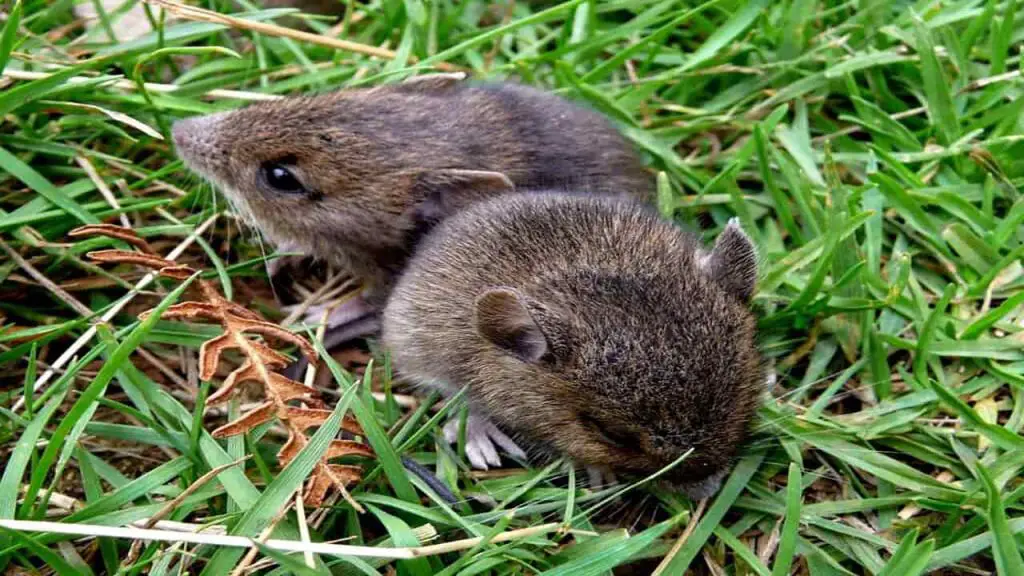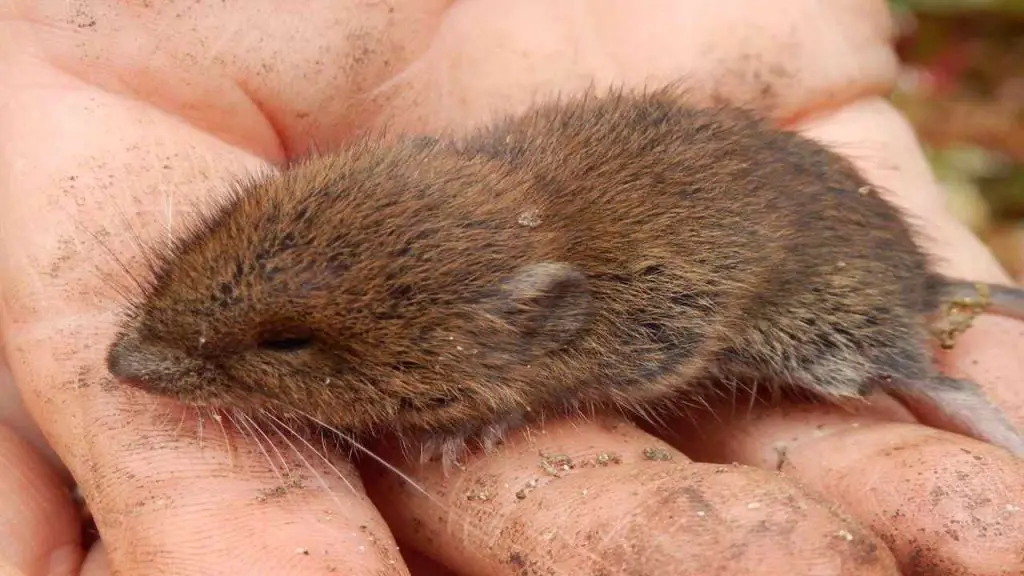As an Amazon Associate I earn from qualifying purchases.
Baby voles are born without any fur and unable to see. They start growing fur after about three weeks and are ready to eat solid food by the time they’re four weeks old.
These little rodents become capable of reproducing when they’re about a month old.
Female voles can have multiple litters throughout the year, with each litter containing between four to seven babies.
In their natural habitat, voles typically live for one to two years, although they can live up to four years in captivity.
They’re small rodents closely related to mice, with brown or black fur and short tails. Voles range in size from about 4 to 8 inches long, including their tails.
When they’re babies, voles mainly eat plants, but as they grow, they also start eating insects and other small animals.
Adults primarily munch on plant roots, stems, and leaves. Unfortunately, voles can cause a lot of damage to crops and gardens by nibbling on plant roots.
They’re also known for tunneling under snow banks and buildings, which can be quite bothersome.
Despite their small size, baby voles are fascinating creatures with intriguing behaviors.
Let’s take a closer look at what they eat, how they hunt, and some interesting facts about these adorable mammals.
What Do Baby Voles Eat: The Complete List of Food

Baby voles, those little critters that look like tiny mice, usually eat what their mothers eat when they’re babies.
They mostly munch on plants like grass, sedges, small plants called Forbes, mosses, and lichens.
Among these, baby voles love clover, which is good news for farmers because they rely on clover as an important part of their diet.
Even though they might try other plants, clover is their top choice.
Likewise, baby voles enjoy eating dandelions too. You can often find these bright yellow flowers in fields and gardens, where baby voles happily nibble on them.
Sometimes they might also snack on fruits like acorns, berries, apples, bananas, and nuts, but not as often.
While grown-up voles usually eat a mix of 80% plants and 20% insects, baby voles mostly stick to plants.
As baby voles grow up, they start to eat more insects like caterpillars, beetles, ladybugs, and June bugs.
By the time they’re adults, their diet is more balanced, with about half being plants and the other half insects.
This change happens because they need more protein as they grow bigger. Insects also give them fat, which is important for their healthy development.
Mosses are also an important part of a baby vole’s diet. They eat different kinds, like sphagnum moss and peat moss, which give them the water they need to stay healthy.
If you ever come across a nest of baby voles, you’ll probably see lots of plants nearby because these little ones spend their time eating vegetation for their meals.
How Do Baby Voles Find Its Food?
Baby voles depend on their sharp senses to find food in their surroundings. Even though they’re tiny, these little rodents have an amazing sense of smell.
This helps them sniff out nearby plants, insects, and other things they can eat. They also have good hearing, which helps them pick up on quiet sounds that might mean there’s food around.
In addition to their sense of smell and hearing, baby voles have sensitive whiskers called vibrissae.
These whiskers help them navigate and explore their environment. They can feel their way through dark or dense areas, like under bushes or in thick grass, to find food hidden under the ground or in plants.
Once they’ve found potential food, baby voles use their instinct to search for it.
They move around quickly, using their flexible bodies to get through grass and bushes, looking for things to eat.
With determination, they’re pretty good at finding plants, insects, and other stuff they need to stay healthy and grow.
How Many Babies Do Voles Have?
Voles are famous for having lots of babies. A female vole can have many batches of babies every year.
Each batch usually has about three to ten babies, but the exact number can change depending on things like the type of vole and the environment they live in.
When these baby voles are born, they’re blind, hairless, and need their mom for everything—like staying warm, getting food, and staying safe.
As they get older, they grow fur, open their eyes, and start doing more things on their own, although they still need their mom for a while.
Because voles have so many babies, they can quickly fill up an area. This can be good and bad for the environment.
They’re an important food for animals that eat them, and they help recycle nutrients in the environment.
But sometimes, they have so many babies that they eat too much vegetation or damage crops on farms.
Habitat of a Baby Vole
A baby vole usually lives where its mom makes a nest, which is often hidden under thick plants or in holes underground.
These nests keep the baby’s voles safe and cosy. Baby voles mostly hang out around the nest, but sometimes they go exploring or looking for food as they get older.
They like living in places with lots of plants, like fields, woods, and gardens because there’s plenty of food to eat and places to hide from animals that might want to eat them.
They also prefer places where the ground is damp, as it’s easier to dig tunnels and find bugs and plant roots to munch on.
The place where a baby vole lives gives them everything they need to stay safe, find food, and grow up healthy.
Interesting Facts About the Baby Vole

Here are some simple facts about baby voles:
1. Tiny Babies: Baby voles, also called pups or kittens, are born very small, usually weighing just a few grams. They’re super tiny compared to grown-up voles.
2. Early Days: When they’re born, baby voles can’t see, have no hair, and rely completely on their moms for everything. They need their mom to keep them warm, feed them, and keep them safe.
3. Grow Quickly: Even though they start so small and needy, baby voles grow fast. In just a few weeks, they grow fur, open their eyes, and start moving around more.
4. Explorers: As they get older, baby voles start to explore. They leave their nest to check out their surroundings and find food. But they still stick close to their moms for help and protection.
5. Love Company: Baby voles like hanging out with each other and their family. They talk to each other with sounds and body language, and sometimes they play together.
6. Lots of Babies: Voles are good at having babies. Female voles can have many batches of babies each year, which helps their population grow. This can have an impact on the environment.
7. Can Live Anywhere: Baby voles are flexible and can live in lots of different places, like fields, forests, and gardens. They can adapt to different environments to find food and shelter.
8. Key Part of the Food Chain: Even though they’re small, baby voles are important. They’re food for other animals like birds and snakes, which helps keep the balance in the ecosystem.
These facts show how interesting and important baby voles are in nature.
Conclusion
Although baby voles are small, they have a big effect on their surroundings because of how they eat and behave.
They have a wide range of foods they like, and they’re clever at finding ways to survive.
These little rodents show us just how tough and flexible nature can be.
Learning about baby voles helps us understand how everything in nature is connected and how important every living thing is to the balance of life.
FAQ’s:
You can feed a vole things like fruits, vegetables, seeds, and grains.
They also like to eat plants like grasses and clover.
Voles love to eat plants, especially things like clover, grasses, and dandelions.
They also enjoy munching on fruits and nuts.
Many animals eat voles, including birds of prey like hawks and owls, snakes, foxes, and some larger mammals like weasels and cats.
Voles have a lot of predators in nature.
It’s not a good idea to keep a vole as a pet. They are wild animals and need specific care and environments to stay healthy.
Plus, in many places, it’s illegal to keep wild animals as pets. It’s best to admire voles from a distance in their natural habitat.
Amazon and the Amazon logo are trademarks of Amazon.com, Inc, or its affiliates.

